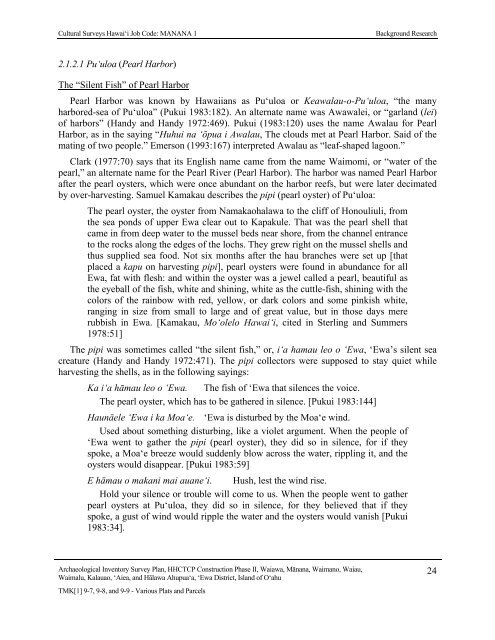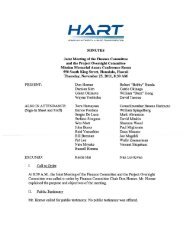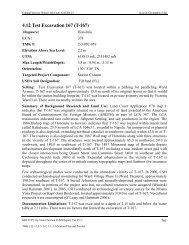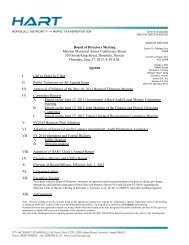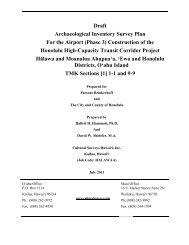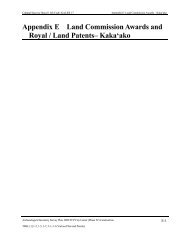AISP Kamehameha Highway Guideway - Honolulu Rail Transit Project
AISP Kamehameha Highway Guideway - Honolulu Rail Transit Project
AISP Kamehameha Highway Guideway - Honolulu Rail Transit Project
Create successful ePaper yourself
Turn your PDF publications into a flip-book with our unique Google optimized e-Paper software.
Cultural Surveys Hawai‘i Job Code: MANANA 1<br />
Background Research<br />
2.1.2.1 Pu‘uloa (Pearl Harbor)<br />
The “Silent Fish” of Pearl Harbor<br />
Pearl Harbor was known by Hawaiians as Pu‘uloa or Keawalau-o-Pu‘uloa, “the many<br />
harbored-sea of Pu‘uloa” (Pukui 1983:182). An alternate name was Awawalei, or “garland (lei)<br />
of harbors” (Handy and Handy 1972:469). Pukui (1983:120) uses the name Awalau for Pearl<br />
Harbor, as in the saying “Huhui na ‘ōpua i Awalau, The clouds met at Pearl Harbor. Said of the<br />
mating of two people.” Emerson (1993:167) interpreted Awalau as “leaf-shaped lagoon.”<br />
Clark (1977:70) says that its English name came from the name Waimomi, or “water of the<br />
pearl,” an alternate name for the Pearl River (Pearl Harbor). The harbor was named Pearl Harbor<br />
after the pearl oysters, which were once abundant on the harbor reefs, but were later decimated<br />
by over-harvesting. Samuel Kamakau describes the pipi (pearl oyster) of Pu‘uloa:<br />
The pearl oyster, the oyster from Namakaohalawa to the cliff of Honouliuli, from<br />
the sea ponds of upper Ewa clear out to Kapakule. That was the pearl shell that<br />
came in from deep water to the mussel beds near shore, from the channel entrance<br />
to the rocks along the edges of the lochs. They grew right on the mussel shells and<br />
thus supplied sea food. Not six months after the hau branches were set up [that<br />
placed a kapu on harvesting pipi], pearl oysters were found in abundance for all<br />
Ewa, fat with flesh: and within the oyster was a jewel called a pearl, beautiful as<br />
the eyeball of the fish, white and shining, white as the cuttle-fish, shining with the<br />
colors of the rainbow with red, yellow, or dark colors and some pinkish white,<br />
ranging in size from small to large and of great value, but in those days mere<br />
rubbish in Ewa. [Kamakau, Mo‘olelo Hawai‘i, cited in Sterling and Summers<br />
1978:51]<br />
The pipi was sometimes called “the silent fish,” or, i‘a hamau leo o ‘Ewa, ‘Ewa’s silent sea<br />
creature (Handy and Handy 1972:471). The pipi collectors were supposed to stay quiet while<br />
harvesting the shells, as in the following sayings:<br />
Ka i‘a hāmau leo o ‘Ewa. The fish of ‘Ewa that silences the voice.<br />
The pearl oyster, which has to be gathered in silence. [Pukui 1983:144]<br />
Haunāele ‘Ewa i ka Moa‘e. ‘Ewa is disturbed by the Moa‘e wind.<br />
Used about something disturbing, like a violet argument. When the people of<br />
‘Ewa went to gather the pipi (pearl oyster), they did so in silence, for if they<br />
spoke, a Moa‘e breeze would suddenly blow across the water, rippling it, and the<br />
oysters would disappear. [Pukui 1983:59]<br />
E hāmau o makani mai auane‘i. Hush, lest the wind rise.<br />
Hold your silence or trouble will come to us. When the people went to gather<br />
pearl oysters at Pu‘uloa, they did so in silence, for they believed that if they<br />
spoke, a gust of wind would ripple the water and the oysters would vanish [Pukui<br />
1983:34].<br />
Archaeological Inventory Survey Plan, HHCTCP Construction Phase II, Waiawa, Mānana, Waimano, Waiau,<br />
Waimalu, Kalauao, ‘Aiea, and Hālawa Ahupua‘a, ‘Ewa District, Island of O‘ahu<br />
TMK[1] 9-7, 9-8, and 9-9 - Various Plats and Parcels<br />
24


